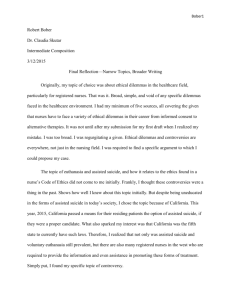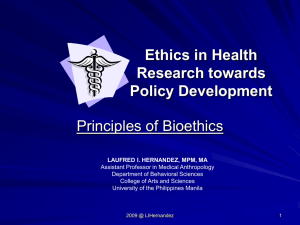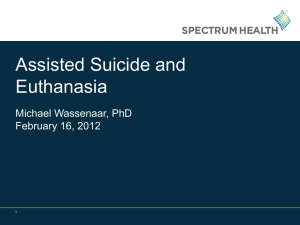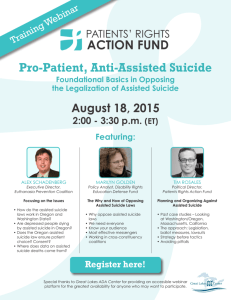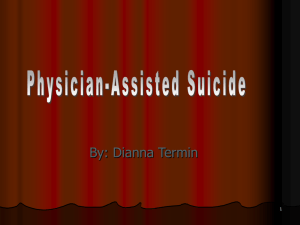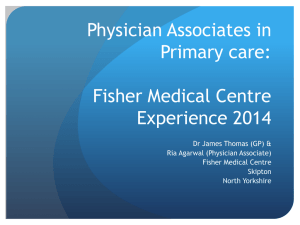Document 10938604
advertisement
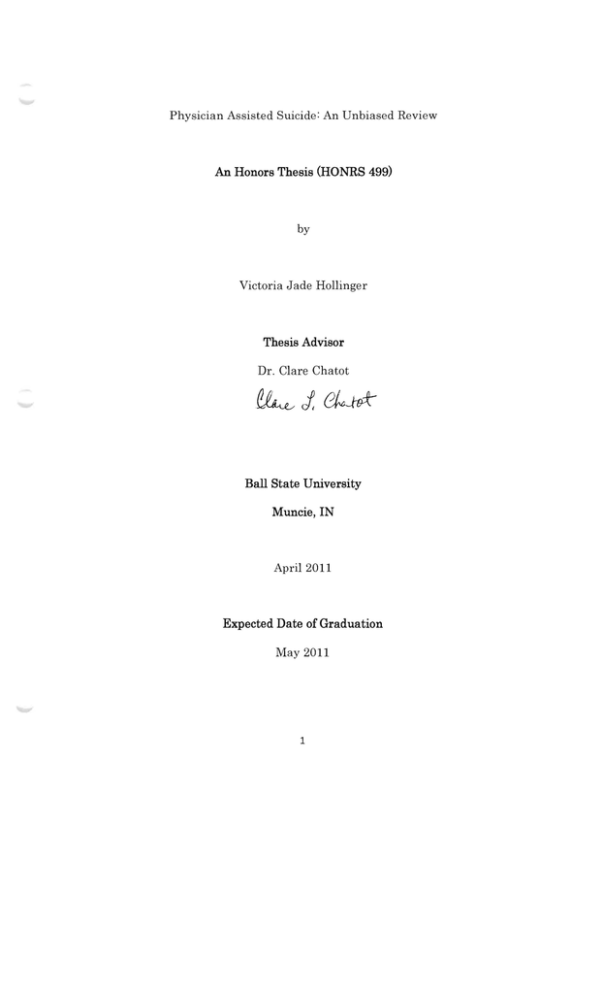
Physician Assisted Suicide: An Unbiased Review An Honors Thesis (HONRS 499) by Victoria Jade Hollinger Thesis Advisor Dr. Clare Chatot Ball State University Muncie, IN April 2011 Expected Date of Graduation May 2011 1 ABSTRACT Medical ethics has become a highly discussed topic in the United States. Physician assisted suicide is one of the most commonly discussed ethical issues in the medical field. Physician assisted suicide dates back to the ancient Greek and Roman empires but has only become a heavily talked about subject in the past century. An unbiased analysis of the ethics behind physician assisted suicide along with the physicians' perspective is challenging and, therefore, rare to find. I attempt to give an unbiased look into the history, pros and cons, current issues, ethics, physician perspective and future of physician assisted suicide with a focus on terminally ill senior patients. This will allow readers to form their own opinions about physician assisted suicide before I reveal my personal opinion on the subject. ACKNOWLEDGEMENTS I would like to thank Dr. Clare Chatot for advising me during this project. Her constant help and encouragement through this difficult task and over the last four years of my undergraduate career has created an environment that allows me to reach my full potential and has also created an amazing professional career path for me in the future. I would like to thank my parents, Kim and Steve Hollinger, for always supporting me and reminding me that I can do anything I put my mind to. I would finally like to thank my grandmother, Diane Weddell, who has been watching over me all of my life. While she cannot be here physically, I know her spirit is always with me and the values she instilled in me many years ago will continue to take me down a path of happiness and success. 2 INTRODUCTION: Physician Assisted Suicide (PAS) has been a controversial subject in the medical field for the past decade . It seems, however, that many people are unaware of the actual meaning of the phrase . PAS is commonly mistaken for euthanasia. Euthanasia is defined as "a physician administers a lethal drug to a suffering patient" (Behuniak, 2003). A second action by physicians that is confused with PAS is called "terminal sedation." Terminal sedation is when "medical care providers administer barbiturates or benzodiazepines to sedate a patient into unconsciousness to control physical suffering." This slows respiration and can cause the patient to have an earlier death. Physicians might also withhold hydration and nutrition to speed up death (Behuniak, 2003). PAS is defined as "a physician assists a patient in dying by writing a prescription for a lethal dose of a drug that the patient self-administers" (Behuniak, 2003). In many cases these terms are considered to be interchangeable when they are actually quite different. PAS is mainly different from euthanasia and terminal sedation because it is self-administered. It is completely the patient's choice to take the prescribed medicine of their own accord. There isn't a doctor "pressing a button" to end their life . There are many supporters and detractors for PAS. Over the past century the number of supporters has increased as people have become more knowledgeable on the issue . In a study in 2003 it was found that supporters were normally "younger 3 Americans, men, whites, democrats and independents" (Behuniak, 2003). Support also correlates to socioeconomic level; the higher a person's level of education and income, the more likely that person is to support physician-assisted suicide. Those that are opposed are mainly "African Americans, older Americans, women, those with low levels of education and household incomes, born-again Christians, and republicans" (Behuniak, 2003). However, when older Americans in retirement facilities are asked if Dr. Jack Kevorkian (the face and "father" of physician-assisted suicide) is a hero or madman almost all of them consider him to be a hero (Colby, 2006). This paper will be focusing particularly into how physicians feel about PAS along with the ethics behind performing PAS on terminally ill seniors. By the end of my research 1 hope to shed some light on this subject from the eyes of the physicians and also on how PAS affects terminally ill seniors. 1 also would like the reader to grasp what it may mean if it is legalized in our state in the future. HISTORY: The controversy of P AS started a lot earlier in history than most might think. The first real discussion of PAS dates back to the time of ancient Greeks and Romans. With the Hippocratic Oath in place doctors weren't allowed to participate in euthanasia or PAS. The Hippocratic Oath states "I will neither give a deadly drug to anybody if asked for it, nor will 1 make a suggestion to this effect" (Medicine Net, 2002). However, "there was widespread support for voluntary death 4 as opposed to prolonged agony, and physicians complied by often giving their patients the poisons as they requested" (Dowbiggin, 2003). This point of view was shunned upon later in the middle ages and in the 17 th century the common law tradition prohibited assisted suicide in America and in 1828 the first US Statute was written that outlawed assisted suicide in New York. This is the Act of Dec. 10, 1828, ch.20, §4, 1828 N.Y. Laws 19. New York commission led by Dudley field drafted a criminal code that prohibited the "aiding" a suicide and, specifically, "furnish[ing] another person with any deadly weapon or poisonous drug, knowing that such person intends to use such a weapon or drug in taking his own life" (Washington v. Glucksberg, 1997). The Field Code was adopted by many territories and became the model that many states used to form their statutes in the 19 th and 20 th centuries. A milestone in PAS occurred in the 1870s when morphine was isolated and used as a pain-relieving agent. A man by the name of Samuel Williams then began advocating for the use of morphine as a way to perform painless assisted suicides. Williams was attacked by the American Medical Association in 1885 for becoming a supporter of PAS and many physicians believed that while morphine was useful in preventing pain it should not be used to hasten death, (Manning, 1994). The first bills to legalize PAS were introduced in 1905 and 1906. Ohio attempted to pass two bills dealing with PAS. The first was a bill to legalize euthanasia which was defeated by a vote of 79 to 23. The second bill wanted to 5 legalize "euthanasia not only for terminal adults but also for hideously deformed or idiotic children." This bill was also defeated (Manning, 1994). While nothing came of both of these attempts they do show that a new modern look at PAS was occurring. Another milestone in PAS occurred in 1915 when Dr. Harry J. Haiselden made the decision to let nature take its course for a newborn whom would only be able to survive its many deformities by a complex surgery with the child's parents in agreement. The child died after five days of life and the actions of Dr. Haiselden caused more Americans than ever before to discuss euthanasia and physician assisted suicide. Many prominent figures supported Dr. Haiselden's decision along with other Americans who now spoke up in support of PAS and euthanasia (Dowbiggin, 2003). By the 1930's, public support of PAS increased greatly. With the Great Depression hitting the United States more people began to support "controlled dying." A public opinion poll in 1937 showed that 45 percent of Americans now supported the mercy killing of "infants born permanently deformed or mentally handicapped" (Dowbiggin, 2003). It took twenty-two years but finally the public accepted Dr. Haiselden's decision in 1915. The Voluntary Euthanasia Act was also introduced in the United States Senate in 1937 by John Comstock, the Nebraska senator. While never voted on it proved that the growing support of euthanasia and PAS was an issue that would soon have to be dealt with by the government (Dowbiggin, 2003). 6 In 1938 the National Society for the Legalization of Euthanasia was founded by Charles Francis Potter and many supporters believed that PAS would soon be legalized by the United States. This would have been true if it were not for World War II and Hitler's use of involuntary euthanasia. Supporters in the United States now had to defend their view of voluntary euthanasia compared to the murders being committed by Nazis in Europe. The perception of PAS was now tainted and support was lost. A poll taken in 1950 "asked Americans whether they approved of allowing physicians by law to end incurably ill patients' lives by painless means if they and their families requested it,"(Dowbiggin, 2003). Only 36 percent said yes to this poll which showed a nine percent decrease in support by Americans compared to the previous pole in 1937 (Dowbiggin, 2003). Over the next twenty years there was little discussion about physician assisted suicide. By 1972, the United State Senate held its first national hearings on euthanasia and physician assisted suicide. This was due to the increasing number of Americans who were not happy with physicians extending the dying process only to subject a patient to a decreased quality of living. In 1973, the Patient's Bill of Rights was created by the American Hospital Association that gave patients the ability to refuse treatment (Zucker, 1999). A Right to Die bill was then created in California in 1976. This bill granted "terminally ill patients the right to authorize the withdrawal of life-sustaining medical treatment when death is believed to be imminent" (New York Times, 1976). Within in the next year, eight 7 states created their own Right to Die bills including: California, New Mexico, Arkansas, Nevada, Idaho, Oregon, North Carolina, and Texas. In 1980 the Hemlock Society was formed in Los Angeles by Derek Humphry. This was one of the biggest organizations promoting euthanasia. The logo for the Hemlock Society explained its views clearly stating "Good Life. Good Death." This was one of the first groups that officially supported active euthanasia and assisted suicide and Humphry became one of the most influential people in the movement for legalization of assisted suicide (Dowbiggin, 2003). The year 1987 marked the time that the first public body supported physician assisted death. The California State Bar passed Resolution #3-4-87 which showed its support for PAS. Then, in 1988, the Unitarian Universalist Association became the first religious body to approve of PAS (Moreno, 1995). By the early 1990s, support for PAS grew to over halfofthe United States population (Vloodman, 2000). This was most likely due to an increase of knowledge about PAS along with only a few "bad instances" involving PAS. The biggest advocate for physician assisted suicide, Jack Kevorkian, became the face of PAS in 1990 when he performed his first assisted suicide on June 4th in the state of Michigan. Over the next few years he became known as "Doctor Death" and assisted many suicides while dealing with the public's and government's view of his actions (Smith, 1997). On June 25 th the United States Supreme Court agreed to hear its first right-to-die case in Cruzan v. Director, Missouri Department of 8 Health. The case dealt with a family whose daughter had become permanently unconscious due to a car accident. Missouri Supreme Court refused to allow the removal of her feeding tube. The Missouri Supreme Court felt that it was not acceptable for the family or anyone else to decide if and when this girl should die. It was considered unlawful to let someone else make that choice for her. After going to the US Supreme Court the feeding tube was finally allowed to be removed (Smith, 1997). In 1991, the first ballot to legalize "physician-aid-in-dying" was introduced in Washington but defeated. After Washington's attempt, California proposed a Death with Dignity Act that allowed physicians to hasten death by prescribing or administering medications for suffering, terminally ill patients. It was defeated by a 54-46 vote. Even though both of these attempts were not successful they laid the ground work for the first Death with Dignity Act to be passed. This occurred for the first time in November 1994 in Oregon making it the first law in United States history to permit PAS (Oregon DWD, 1994). Many attempts to change this law were unsuccessful in Oregon after it was passed which made it the only state to legalize PAS for fourteen years. Michigan was the next state to attempt to legalize PAS in 1998 but failed. This resulted in Jack Kevorkian being convicted of murder in 1999. Maine also attempted to create a Death with Dignity Act but it was also defeated. In 2008 Washington voters approved its Death with Dignity Act and became the second state to legalize physician assisted suicide. The third state to legalize PAS was Montana only a month after Washington legalized it. 9 These are the only three states that have successfully legalized PAS as of today. Many more attempts are sure to be made by other states over the next decade. Many will fail but a few will succeed and join Oregon, Washington, and Montana in the controversy of having legalized Physician Assisted Suicide. PROS AND CONS: There are plenty of pros and cons from both of the opinions on physician assisted suicide. In order to give an unbiased view, this section will look at some of the main arguments posed by both sides and the pros and cons of these arguments. The first argument is that people have the right to die. The pro side of this statement says "The right of a competent, terminally ill person to avoid excruciating pain and embrace a timely and dignified death bears the sanction of history and is implicit in the concept of ordered liberty," and that a "terminally ill person has a protected liberty interest in choosing to end intolerable suffering by bringing about his or her own death" (ACLU Amicus Brief in Vacco v. Quill). The con side argues that assisted suicide is illegal (in most states) and due to this "the asserted 'right' to assistance in committing suicide is not a fundamental liberty interest protected by the Due Process Clause" (Washington v. Glucksberg 1997). Overall, the people against PAS feel that since it is illegal to participate in assisted suicide it is therefore, not a person's right to commit suicide or help commit suicide. A second argument that is made by supporters of PAS is that a patient is suffering at the end of their life and should not have to. Faye Girsh, the Senior 10 Adviser of Final Exit Network, stated that "it should be considered as much of a crime to make someone live who with justification does not wish to continue as it is to take a life without consent." Girsh also said that "desperate people are looking for someone like Jack Kevorkian to end their lives which have lost all quality." Those tha t don't believe in assisted suicide counter this argument by saying the government is not purposely trying to make people suffer but that "laws against assisted suicide are in place to prevent abuse and to protect people from unscrupulous doctors and others," (Marker, 2010). Those against PAS are known to bring up the fact that legalizing PAS is a slippery slope to legalizing murder. They believe that legalizing assisted suicide will open the door for the euthanasia of those that cannot give consent or allowing the euthanasia of a patient without asking for consent (Pelligrino, 1998). While those that approve of PAS recognize this concern they also do not feel that the possibility of this happening is worth not attempting to legalize assisted suicide. They feel that there needs to be concrete evidence that this will occur before giving up on the idea of PAS (Frey, 1998). One of the biggest controversies when discussing PAS is the Hippocratic Oath. It clearly states that "I will neither give a deadly drug to anybody if asked for it, nor will I make suggestion to this affect," and also that a doctor must "do no harm" to a patient. Protestors of assisted suicide use this time and time again in order to prove the point that it is against a physicians main values to help a patient die. Their argument is simple and is supported by one of the oldest documents that 11 physicians still follow to this day. Supporters of PAS argue that the Hippocratic Oath has been modified in the past and that it is possible to do so now and in the future. They also argue that ifit is the physicians job to "do no harm" then they should be able to end the life of a terminally ill suffering patient since keeping them alive is indirectly harming them by making them live through the pain of their illness. By having the power to end their life early they would actually be following the Hippocratic Oath by ending the harm that is being done to them by their illness. While these are the main pros and cons of PAS there are a few other widely discussed points made by both sides. When looking at pros of physician assisted suicide, some other arguments that have been made are that health care costs can be reduced, preventing suicide is against religious freedom, vital organs can be given to those in need, and that suicide will be committed with or without physician assistance so it is better to provide a safer and less traumatic option to those desperate people. Some of the other cons of PAS include the idea that insurance companies may put pressure on physicians to not try certain procedures and to just recommend assisted suicide, doctors are given too much power, and that patients and their families will give up hope to early and choose assisted suicide when there are other treatments that may save the patient's life. In summary, all of the pros and cons of PAS have been discussed thoroughly by many. It is difficult to determine who has the best argument or if there are more pros or more cons to physician assisted suicide. My advice is to attempt to picture what you would want 12 available to yourself as a suffering, terminally ill patient or to a family member in the same position. CURRENT ISSUES: With only three states that have legalized PAS there is bound to always be cases in which assisted suicide is being discussed. There are estimated to be over one thousand assisted suicides occurring in a year. However, since it is mostly illegal to participate in assisted suicide most of them are kept quiet and do not make it to court (ERGO, 2010). The most recent case to reach court is due to the Final Exit Network. This group of assisted suicide supporters have been closely watched for years but finally in 2008 four of them were charged with assisting a suicide, tampering with evidence, and racketeering. How did all of this come about? The Final Exit Network was founded in 2004 and its volunteers are willing to sit with terminal persons as they end their lives. A guide is assigned to a person who wants to die once they join the Final Exit Network . This guide then helps the suffering person get approved for help. Once approved the guide gives information on where and how to get the needed equipment to perform the suicide and may be present at the time of the suicide as well. In most cases the equipment used is a helium tank and a bag. The suffering person places the bag over their head and then fills it with the helium gas which will deplete the oxygen and therefore the patient will die. 13 In 2009, disaster struck the Final Exit Network in Georgia as four of their members were charged in the death of a man named John Clemens due to an undercover agent who acted as a sick man with pancreatic cancer. John Clemens was known to have cancer of the throat and mouth and had undergone extensive surgery over the years and still had many more to go through. In June 2008 he was pronounced dead after inhaling helium. Two of the four that were charged were said to be holding Mr. Clemens' hands at the time of his death which could have kept him from pulling the hood off (Mail Foreign Service, 2009). Georgia's statute on assisting suicide says anyone who "publicly advertises, offers, or holds himself or herself out as offering" to assist with a suicide is guilty of a felony. There was much dispute about if this law was actually just keeping people quiet about suicide and therefore violating their right to free speech and if the members of the Final Exit Network violated this law (UPI, 2010). The mother of John Clemens stated that "If they helped John to die, that is what he wanted. I would never find them guilty for helping him" (Mail Foreign Service, 2009). With so much controversy over the laws and the fact that his mother did not wish to press charges the case was postponed indefinitely in August 2010. When and if more information arises on the Final Exit Network's involvement in assisted suicides this case can be reopened and used as evidence (ERGO, 2010). 14 ETHICS OF PAS: When looking into how ethical PAS is, it is important to understand what is meant by the term 'ethical'. An accepted definition from Dictionary.com of the term ethical is "being in accordance with the accepted principles of right and wrong that govern the conduct of a profession." In the medical profession the two major principles that govern their profession are the Hippocratic Oath and the laws of their state and country. The Hippocratic Oath has been covered previously in this paper but there are two major parts of it that create ethical issues for physician assisted suicide . The first of these issues is that the Hippocratic Oath states that a physician will not help a patient commit suicide in any way. Obviously this contradicts what PAS is all about. While it is possible to change the Hippocratic Oath it will be hard to gain the majority support of physicians and law makers for this change and it definitely poses an ethical issue with physician assisted suicide. The second ethical issue with PAS and the Hippocratic Oath is that it states to do no harm . Most feel that by helping in the suicide and death of a patient the physician is doing harm to the patient. Since every physician must follow this oath it is hard to find a way to justify assisted suicide. However, some feel that by prolonging the suffering of a patient the physician is actually causing more harm than good. 15 Physicians are also bound by the law to act ethically and follow the principles set out by their state and their country. Proponents and opponents have a different idea of what is ethically correct or incorrect about physician assisted suicide. Those who support PAS say that it "is ethically acceptable-it is in accord, they argue, with basic principles of liberty and self-determination, and by allowing a dying person to satisfy his or her own values without posing serious harms to others, it satisfies the requirements of consequentialist, utilitarian moral systems" (Battin). On the other hand, opponents feel that it isn't ethically acceptable because "fundamental morality prohibits killing, including self-killing, and that allowing even sympathetic cases of physician assistance in suicide would lead down the 'slippery slope,' as overworked doctors, burdened or resentful family members, and callous institutions eager to save money would manipulate or force vulnerable patients into choices of suicide that were not really their own" (Battin, 2011). Overall, the ethical issues of PAS have become one of the major reasons it isn't legal in more states. If the majority of the population feels that it is not ethical to assist in suicides then PAS will never be completely accepted. While all of these ethical issues could easily be changed, it needs to be widely accepted and discussed beforehand. THE PHYSICIAN PERSPECTIVE: With so much talk about PAS in the news and laws being passed in multiple states allowing its practice, it is important to discuss the views of physicians on assisting suicide. Physicians have felt the pressure to choose a side when it comes to 16 this subject and many may also feel that their choice will greatly affect their job security. For this reason, many polls have been done in order to gauge the position that physicians take on assisted suicide. The data I will be using is from a national survey done in 2008 regarding physician's opinion on physician assisted suicide, terminal sedation, and withdrawal of life support. I will also compare these results to results from other countries that have legalized physician assisted suicide. The United States survey not only focused on if physicians objected or approved of physician assisted suicide, but it also associated these feelings with religious characteristics and experience caring for terminal patients. The survey received about 1000 answers from physicians and was done by mail. Looking at the overall percentages this survey found that 69% object to physician assisted suicide, 18% object to terminal sedation, and 5% object to withdrawal of life support. When looking at the factors that may influence these results they found that those that are highly religious, of Asian ethnicity, of Hindu religious affiliation, and that have more experience caring for terminal patients are more likely to object to PAS and terminal sedation. Religious practices seem to play one of the biggest roles in this decision making. The survey showed that 84% of those who were highly religious objected to PAS while only 55% of those with low religiosity objected. Overall, the results showed that a majority of physicians do not approve of PAS and that the physician's personal background and experience contributes to their feelings on the subject (Farr, 2008). 17 Another survey was done in 2009 asking similar questions to physicians in the UK. This was a postal survey taken of 3733 UK medical practitioners. This survey showed comparative results to that of the US survey. A majority of the doctors were opposed to PAS with palliative medicine specialists being more opposed. Strong religious beliefs caused a greater opposition but experience in treating terminally ill patients didn't have any association with opinions on PAS like it did in the United States (Seale, 2009). A third survey was done in Sweden in 2008. This was also a postal survey sent out to 1,200 physicians in a range of specialties that include: general practice, geriatrics, internal medicine, oncology, psychiatry and surgery. The survey had a 74% response rate and had quite different results from the surveys done in the United States and UK. Results showed that "34% were pro physician assisted suicide, 39% against it and 25% were doubtful" (Lindblad, 2008). Compared to the other two surveys, this survey had a very low percentage of physicians that opposed PAS and a large number of physicians that were just doubtful of the practice. They did, however, match US and UK results when looking specifically at physicians who deal with terminally ill patients. They found that physicians that practiced oncology were the most likely to oppose PAS while psychiatrists were most likely to support it. This survey shows that there is a change in physician's views about assisted suicide. While this is not the United States the point of including this information is to show that other countries are slowly becoming more accepting of PAS and that a 18 change of heart might also be possible in the US over the next decade. (Lindblad, 2008) These surveys were found to have the most conclusive data out of the information available at this time. In each case, more research should be done to broaden the results and also to find out how the opinion of physicians is changing over the upcoming years. The fact that these surveys are even taking place shows that PAS is slowly being considered by more countries and more physicians as the years pass. This alone, proves that a change is coming in the medical field and that PAS is becoming a very big issue that must be discussed in every state and every country in the upcoming years. FUTURE OF PAS: With the large number of surveys and increased information becoming available over the past ten years about PAS it is impossible to ignore this subject today. The future of PAS is in the hands of all the people that live and vote in the United States. With three states already having decided to change their position on PAS it is impossible to say that others will not follow suit. Over the next decade I believe that PAS will be discussed by many other states in the US if it does not become a nation-wide discussion in that time. With the baby-boomer generation starting to face all of the hardships of old age and illness it is very possible for many more people to turn to PAS in order to end their own suffering or that ofloved ones. However, support of PAS is not as strong as it will need to be in order to get more 19 states to legalize it. More information needs to be given to the general population about what physician assistant suicide really is, how it works, and an unbiased list of pros and cons. The opinion of America's population is the only thing that will truly decide if PAS is acceptable or not. Therefore, the future of PAS depends on the ability of scholars, physicians, and media to get the correct, unbiased information out to the United States citizens and on the deciding vote of Americans. PERSONAL OPINION: Throughout this paper I have attempted to keep my opinion to myself and give an unbiased look at all of the information available to the public about PAS and compile it into one document that can be understood by the general public. I'm sure, however, that in the process of composing this paper I have hinted at how I feel about physician assisted suicide. At the beginning of this paper I honestly had little knowledge of all the aspects that have gone into PAS becoming a medical ethics issue of today. After doing this research I can say that I'm truly knowledgeable on the subject and I hope you, as a reader, are as well. With some preconceived opinions from the beginning and after all of this research I would have to say that I do support PAS being approved in the future. I do not think the United States is ready to tackle this issue today but I do think that over the next 20 years or so we should be able to confront PAS with confidence. Those states that have already legalized PAS have been able to control its usage and have seen only minor side effects. I believe that this does need to be a state-by­ 20 state choice but that each state must also work with surrounding states in order to create an environment that is healthy and safe when legalizing physician assisted suicide. I believe that PAS should only be available to those who are terminally ill and who have exhausted all other resources. This is also true when discussing my opinion on terminal sedation or euthanasia with long-term coma patients or patients that have been living on life support for an extended amount of time. While the focus of my research was initially on how PAS affects terminally ill seniors, I believe the information I found can be looked at for any terminal patient. It is, however, more accepting for a terminally ill senior to undergo PAS than a toddler that is terminally ill. When looking at younger adults and children I do not believe it is acceptable to choose PAS as a way to escape from any kind of disability or syndrome. PAS should only be available to end the suffering of a terminally ill patient that is in immense pain or unable to live any sort of life . I do believe that physicians should be able to choose to perform or not perform assisted suicides in their offices and that they should not feel pressured to conform to a state's decision to legalize it if they aren't comfortable doing so. Since I am going into the medical field myself I feel that this is a choice I would not want to be pressured into or see other doctors pressured into either. I feel that some physicians will change their mind on how they feel about PAS if it is legalized in their state just because there will be a demand for those physicians but if not the physician should always be able to choose if they are willing to perform these procedures . 21 CONCLUSION: The idea of this paper is to open the eyes of the readers and give them information to make their own choice on whether they support physician assisted suicide. It is necessary for every person to become knowledgeable in this matter due to the rise in the subject's popularity in the medical realm. The history of PAS shows how it has grown to become a prominent subject in the medical field and how the view of the public drastically affects how each state decides to handle physician assisted suicide. The list of pros and cons could go on for pages and pages but the ones given help show how each side of the argument has obtained its view. The ethics of PAS are obviously one of the biggest concerns of physicians and the public. In order for PAS to be accepted by the majority of both physicians and the public it needs to be deemed ethical and for it to be completely unaccepted it must be deemed completely unethical by the United States. Hopefully, after reading this you feel like you can form your own opinion on PAS and can say that you understand both sides of the argument and why it has become such a prominent issue in today's world. 22 WORKS CITED Battin, M. (2011). Suicide and Ethical Aspcts Assisted Suicide- The public debate over physician - assisted suicide. Retrived from http://medicine.jrank.org/pages/1705/Suicide-Assisted-Suicide-Ethical­ Aspects.html. Behuniak, S. M., & Svenson, AG. (2003). Physician-Assisted Suicide: The Anatomy of a Constitutional Law Issue. New York: Rowman & Littlefiled Publishers, Inc. Colby, W. (2006). Unplugged: Reclaiming our Right to Die in America. New York: American Management Association. Dictionary.com (2011). Definition ofEthical. Retrieved March 7 th , 2011, from http://dictionary.reference .comlbrowse/ethical. Dowbiggin, I. (2003). A Merciful End: The Euthanasia Movement in Modern America. New York: Oxford University Press Inc. Euthanasia Research & Guidance Organization (2010). Frequently Asked Questions. Retrieved March 7 th , 2011, from http://www.finalexit.org/ergo faq.html#16. Farr, C. et al. (2008). To Die} to Sleep: US Physicians} Religious and Other Objections to Physician-Assisted Suicide} Terminal Sedation} and Withdrawal ofLlfe Support. American Journal of Palliative Care. 25 (2).112-120. Retrieved from http://ajh.sagepub.com/contentl25/21112.short. Frey, RG. (1998). The Fear ofa Slippery Slope) Euthanasia and Physician-Assisted Suicide: For and Against. UK: Cambridge University Press. Leo, D. (2001). Suicide and Euthanasia In Older Adults: A Transcultural Journey. Seattle, WA: Hofrefe & Huber Publishers. Lindblad, A (2008). Physician-assisted suicide: a survey ofattitudes among Swedish physicians. Scandanavian Journal of Public Health. 36(7). 720-727. Retrieved from http://sjp.sagepub.com/contentl36171720.short. Mail Foreign Service. (2009). Four charged in assisted suicide ring as FBI investigates "Final Exit Network}~ Retrieved from http://www .dailymail.co.uk/news/worldnews/article-1155883/Four-charged­ assisted-suicide-ring-FBI-investigates-Final- Exit- Network.html. Manning, M. (1994). The History ofEuthanasia Debates in the United States and Britain. Annals of Internal Medicine. Marker, R (2010). Euthanasia and Assisted Suicide: Frequently Asked Questions. International Task Force on Euthanasia and Assisted Suicide. Retrieved from: www.internationaltaskforce.org. 23 MedicineNet Inc. (2002). Hippocratic Oath. Retrieved March 7 th , 2011, from http://www.medterms.com/scriptimainiart.asp?articlekey=20909. Moreno,!' (1995). Arguing Euthanasia: The Controversy Over Mercy Killing, Assisted Suicide, and the 'Right to Die.' New York· Simon & Schuster. New York Times. (October 2, 1976). Cahfornia Grants Terminally III Right to Put an End to Treatment. Oregon Death with Dignity Act. (1994) Retrieved March 7 th , 2011, from http://euthanasia .procon.org/sourcefiles/DWDApdf. Pelligrino, E. (1998). The False Promise ofBeneficent Killing, Regulating How We Die: The Ethical, Medical, and Legal Issues Surrounding Physician-Assisted Suicide. ProCon Org. (2010) History ofEuthanasia and Physician-Assisted Suicide. Retrieved March 7 th , 2011 , from http://euthanasia .procon.org/view .resource .php ?resourceID=OOO 130. ProCon Org. (2010). Should euthanasia or PASbe legal? Retrieved March 7 th , 2011, from http://eu thanasia .procon.org/view .resource .php ?resourceID=OOO 126. Seale, C. (2009). Legalisation of euthanasia or physician-assisted suicide: survey of doctors' attitudes. Palliative Medicine. 23 (3). 205-212. Retrieved from http://pmj.sagepub.com/content/23/3/205.short. Smith, W. (1997). The Slippery Slope from Assisted Suicide to Legalized Murder. New York: Random House. United Press International. (2010). 4 say not guilty in assisted suicide case. Retrieved from http://www.upi.com/Top News/US/2010/04/01l4-say-not-guilty-in-assisted­ suicide-case/UPI-92451270174938/. Vacco v. Quill. (1996). American CivJl Liberties Union Amicus Brief Retrieved March 7 th , 2011, from http://euthanasia.procon.org/sourcefilesNaccovQuillAmicus.pdf. Washington et. al. v. Glucksberg et. al. (1997). United States Supreme Court. No. 96­ 110. 521 U.S. 702. Woodman, S. (2000). Last Rights: The Struggle to Die. Massachusetts: Perseus Publishing. Zucker, M. (1999). The Right to Die Debate: A Documentary History. Westport, CT: Greenwood Press. 24
